Imagine having a miniature garden in your home, filled with lush greenery and vibrant plants. Terrarium plants make this possible, and with over 25 identified options beneficial for indoor gardening, you can create a unique and thriving ecosystem. From miniature ferns to mosses, these plants are perfect for indoor gardening and require minimal care.

With terrarium plants, you can bring a touch of nature into your home and enjoy the benefits of indoor gardening. Whether you’re a seasoned gardener or a beginner, terrarium plants are a great way to elevate your indoor garden and add some greenery to your space.
Table of Contents
What Are Terrarium Plants?
When it comes to creating a miniature garden, terrarium plants are the way to go. These plants thrive in a closed or partially closed environment, making them perfect for succulent terrarium and air plants enthusiasts. With the right combination of plants, you can create a self-sustaining ecosystem that requires little to no maintenance.

Some popular types of terrarium plants include mosses, ferns, and dwarf conifers. These plants are well-suited for low-light environments and can thrive in humid conditions, making them perfect for closed terrariums. On the other hand, open terrariums can accommodate plants that are tolerant of above-average humidity, such as cacti and succulent terrarium plants.
When selecting plants for your terrarium, it’s essential to consider their size, growth habit, and lighting requirements. Here are some factors to keep in mind:
- Choose plants that are small enough to fit comfortably in the terrarium container
- Select plants that can thrive in low-light conditions, such as mosses and ferns
- Consider the humidity levels required by each plant, and choose plants that can tolerate the same conditions
A succulent terrarium can be a beautiful and low-maintenance addition to any room. With the right plants and a little creativity, you can create a stunning miniature garden that will thrive in a closed environment. Whether you’re a seasoned gardener or just starting out, air plants and succulent terrarium plants are a great choice for anyone looking to bring some greenery into their home.
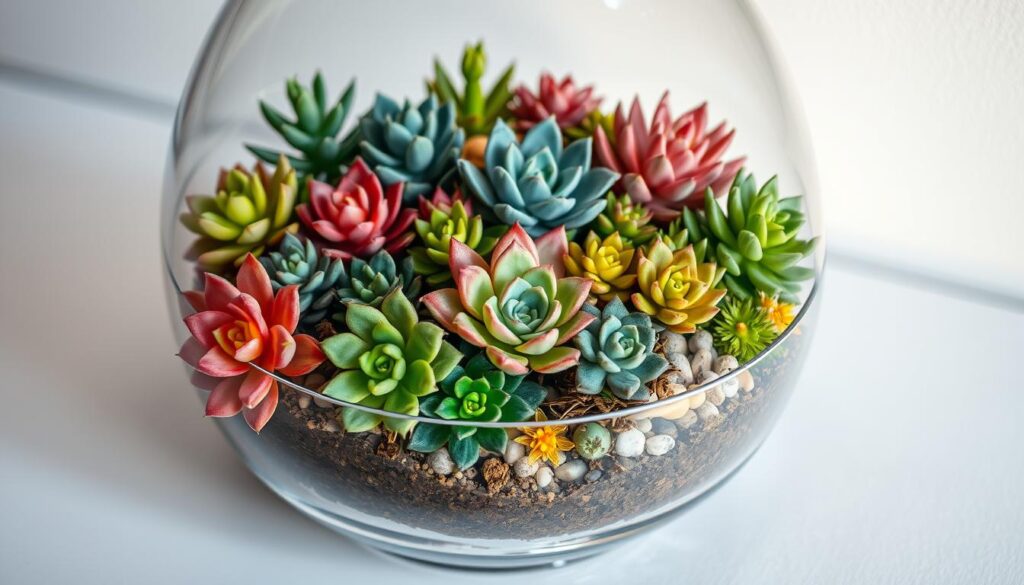
Here’s a table summarizing some popular terrarium plants and their characteristics:
| Plant Type | Lighting Requirements | Humidity Levels |
|---|---|---|
| Mosses | Low | High |
| Ferns | Low-Medium | Medium-High |
| Succulents | Medium-High | Low-Medium |
Benefits of Having Terrarium Plants
When it comes to adding a touch of elegance to your home, terrarium plants are an excellent choice. Not only do they bring a sense Doppler of calm and tranquility, but they also help to purify the air, making them a great addition to any room. With the right miniature garden and terrarium supplies, you can create a beautiful and thriving indoor garden.
Some of the benefits of having terrarium plants include:
- Improved air quality: Terrarium plants help to remove pollutants and toxins from the air, making it healthier to breathe.
- Aesthetic appeal: Terrariums can add a touch of elegance to any room, and can be used to create a sense of calm and tranquility.
- Low maintenance requirements: Terrariums typically require watering every few weeks to months, making them perfect for busy people.
With a well-designed miniature garden and the right terrarium supplies, you can enjoy the many benefits of terrarium plants. Whether you’re looking to add a touch of elegance to your home or simply want to purify the air, terrarium plants are a great choice.
Here is a table showing some of the benefits of terrarium plants:
| Benefit | Description |
|---|---|
| Improved Air Quality | Removes pollutants and toxins from the air |
| Aesthetic Appeal | Adds a touch of elegance to any room |
| Low Maintenance Requirements | Requires watering every few weeks to months |
Popular Terrarium Plants to Consider
When it comes to choosing the right plants for your terrarium, there are many options to consider. You’re looking for terrarium ideas that include plants that are relatively low-maintenance and can thrive in a closed or partially closed environment. Some of the best plants for terrariums include moss varieties, succulents, and ferns.
These plants are ideal for terrarium ideas because they are adapted to living in environments with limited space and specific conditions. For example, moss and ferns prefer high humidity, while succulents are more tolerant of dry conditions, making them suitable for a variety of terrarium ideas.
Moss Varieties
Moss is a fundamental element in closed terrariums, needing constant moisture and indirect sunlight. It’s one of the best plants for terrariums due to its ability to thrive in low-light conditions.
Succulents
Succulents are perfect for open terrariums, which lack humidity. They are slow-growing, making them ideal for terrariums as they won’t crowd the space quickly. Consider them for your terrarium ideas if you prefer a low-maintenance option.
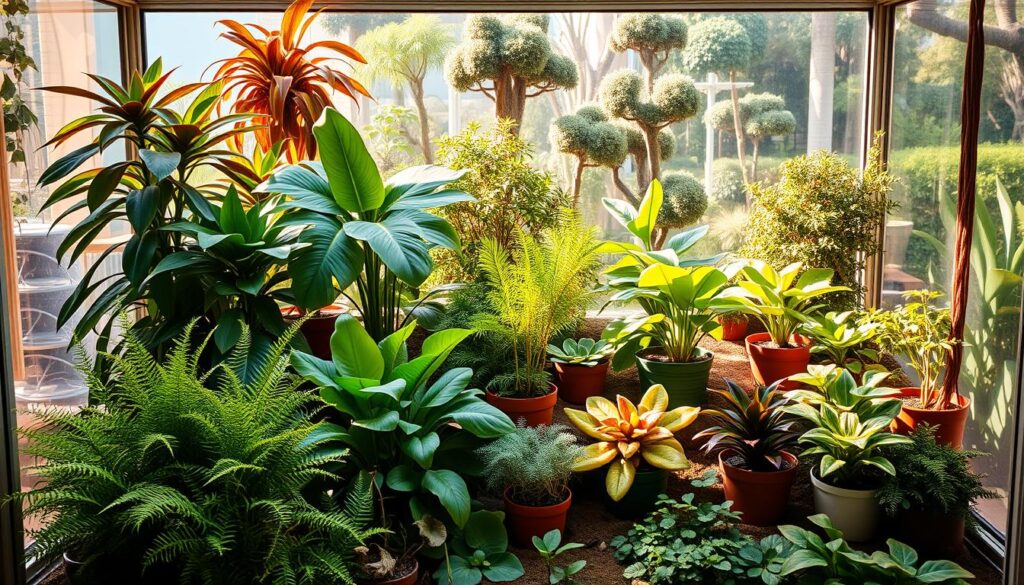
Ferns
Ferns are another great option for closed terrariums. They thrive in humid conditions, making them a suitable choice. Look for compact varieties to include in your terrarium ideas.
How to Choose the Right Terrarium Plants
When it comes to selecting terrarium plants, there are several key factors to consider. To create a thriving miniature garden, you’ll want to think about the terrarium design essentials, including the plants’ light requirements, size, and growth habit. By choosing the right terrarium plants, you can create a beautiful and low-maintenance indoor garden.
Some popular terrarium plants include ferns, foliage plants, and vines. These plants are well-suited to the high humidity environment of a terrarium and can thrive in conditions with low light. When selecting plants, consider their compatibility with other plants and the overall aesthetic you want to achieve. A well-designed terrarium can be a stunning addition to any room, and with the right plants, you can create a unique and captivating display.
To get started, consider the following tips:
- Choose plants that are adapted to high humidity and low light conditions
- Select plants with similar growth habits and requirements
- Consider the size and scale of the plants in relation to the terrarium container
By following these guidelines and considering the terrarium design essentials, you can create a beautiful and thriving terrarium that showcases your favorite plants. Remember to research the specific needs of your chosen plants and provide them with the right conditions to thrive. With the right plants and a little care, your terrarium can become a stunning and unique addition to your home.
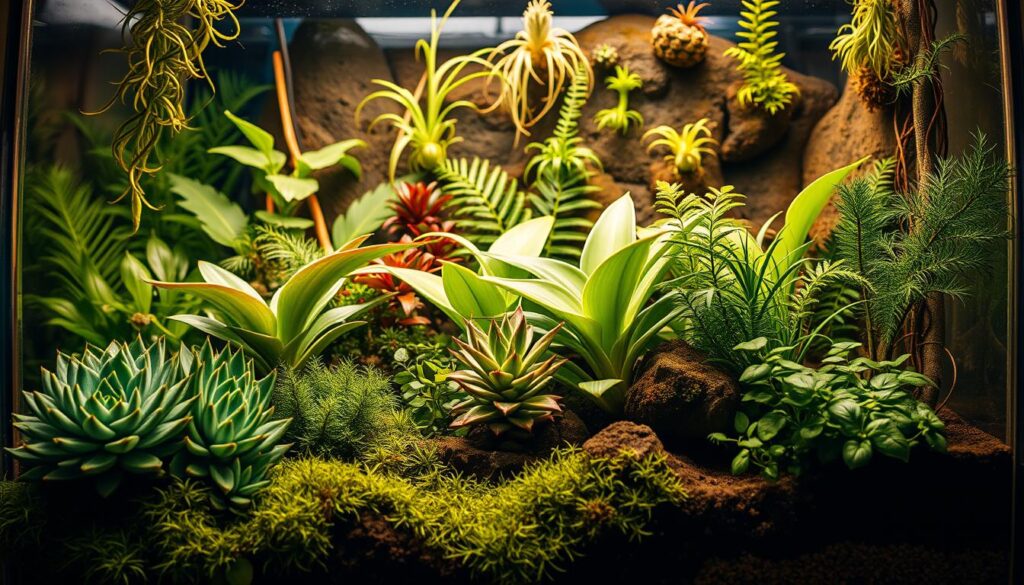
| Plant | Light Requirements | Growth Habit |
|---|---|---|
| Nerve Plant | Low to Medium | Compact, spreading |
| Selaginella | Low to Medium | Trailing, mat-forming |
| Polka Dot Plant | Medium to High | Upright, bushy |
Creating the Perfect Terrarium Environment
When it comes to indoor gardening, a well-crafted terrarium can be a beautiful and low-maintenance addition to your space. To create a thriving environment for your plants, it’s essential to consider the container, drainage, and layering materials. A succulent terrarium is a great option for those who want to add some greenery to their home without the hassle of constant upkeep.
A suitable container is crucial for a healthy terrarium environment. The right size and shape will help to create a balanced ecosystem for your plants. Consider a container that is at least 5-7 inches deep to allow for proper drainage and root growth. A clear glass or plastic container is ideal, as it will allow for Corona light to reach your plants.
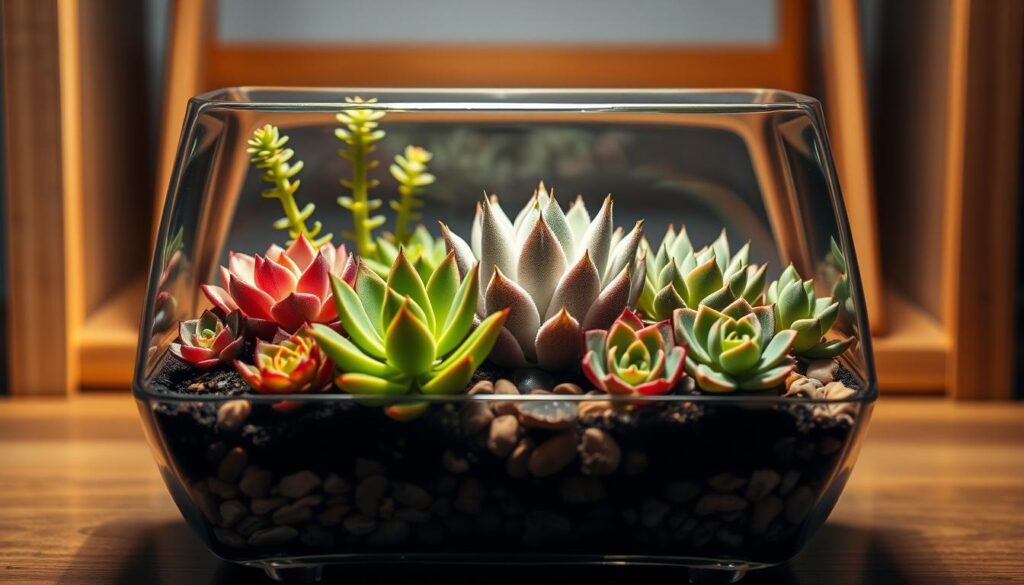
Proper drainage is critical to prevent waterlogged soil and root rot. A 2-inch layer of coarse gravel, sea glass, or beach stones at the bottom of the container will help to ensure that excess water is drained. Adding a layer of activated charcoal on top of the drainage layer will help to keep the water fresh and prevent bacteria growth.
Layering Materials
The base layer of your terrarium should occupy one-quarter to one-third of the container’s total space. This layer should consist of a mixture of small stones or pebbles, followed by a layer of activated charcoal. The next layer should be a handful of potting soil, followed by your chosen plants. Leave about a half-inch layer of soil on top to cover the plants after placement.
By following these guidelines, you can create a thriving indoor gardening environment that is perfect for your succulent terrarium. With the right container, drainage, and layering materials, you’ll be on your way to creating a beautiful and low袋aintenance terrarium that will bring joy and freshness to your space.
How to Assemble Your Terrarium
Assembling a terrarium can be a fun and creative process. To start, choose a container that fits your desired miniature garden style. Consider the size and shape of the container, as well as the type of plants you want to include. Air plants are a great option for terrariums, as they are low-maintenance and can thrive in a variety of conditions.
Once you have your container, it’s time to start layering your materials. Begin with a 2-inch layer of gravel or crushed stone for drainage purposes. This will help prevent water from accumulating in the soil and reduce the risk of root rot. Next, add a layer of activated charcoal to help control odors and improve drainage.
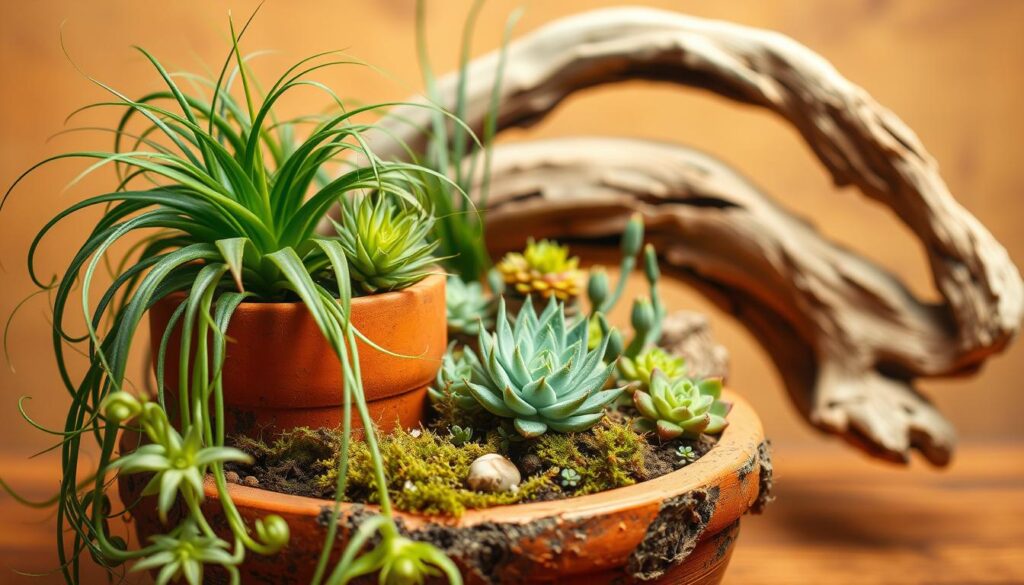
When it comes to choosing plants for your terrarium, consider the amount of light they require. Most terrarium plants prefer low to medium light levels, so be sure to choose plants that fit your lighting conditions. Some popular options for terrariums include mosses, succulents, and ferns. These plants are all relatively small and can thrive in the humid environment of a terrarium.
To ensure your terrarium remains healthy and thriving, be sure to inspect it regularly for condensation and excess water. If you notice any issues, remove the top of the terrarium until the condensation disappears. With proper care and attention, your air plants and miniature garden can thrive for years to come.
Caring for Your Terrarium Plants
To keep your terrarium plants healthy and thriving, it’s essential to provide them with the right care and maintenance. This includes using the right terrarium supplies, such as a well-draining potting mix and a balanced fertilizer. When it comes to terrarium ideas, consider the type of plants you want to include and the level of maintenance you’re willing to provide.
Watering is a critical aspect of terrarium care. For open terrariums, water succulents and cacti weekly from March to October, using about 1 dessertspoon of water per plant. In closed terrariums, condensation should ideally reach up to one-third of the height of the jar for optimal humidity levels. Here are some tips for caring for your terrarium plants:
- Water carefully, as overwatering can lead to mold and root rot.
- Prune plants regularly to maintain shape and promote healthy growth.
- Monitor temperature and humidity levels to ensure they are within the optimal range for your plants.
By following these tips and using the right terrarium supplies, you can create a beautiful and thriving terrarium that brings joy and serenity to your space. Remember to research and understand the specific needs of your plants, and don’t hesitate to experiment with different terrarium ideas to find what works best for you.
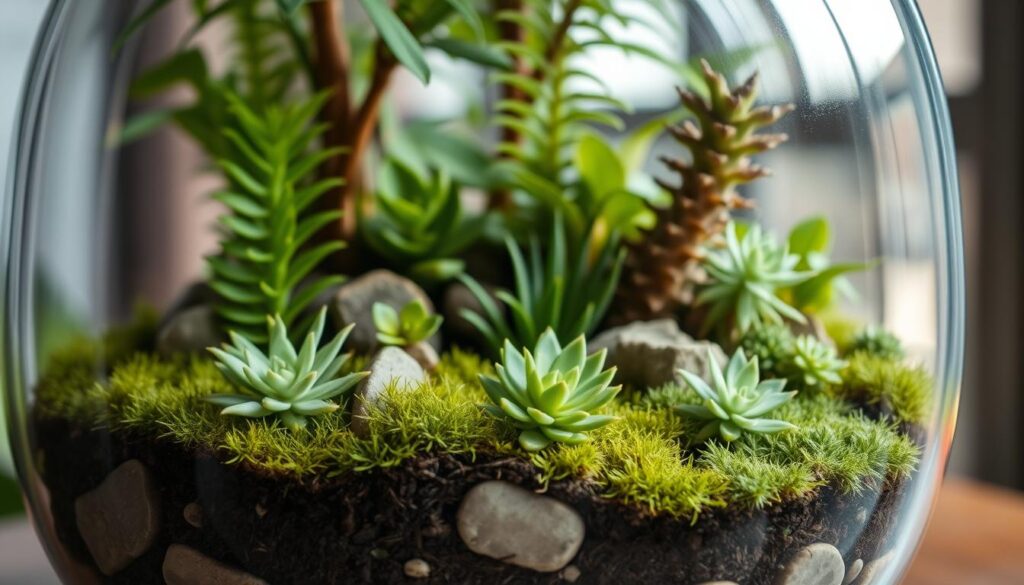
| Terrarium Type | Watering Frequency | Humidity Level |
|---|---|---|
| Open Terrarium | Weekly | Low |
| Closed Terrarium | Every 3-6 months | High |
Using Terrarium Plants for Home Decor
When it comes to adding some greenery to your home decor, terrariums are an excellent option. They provide a unique and creative way to display plants, and with the right terrarium design essentials, you can create a beautiful and thriving miniature garden. The best plants for terrariums are those that thrive in high humidity and low light conditions, such as ferns and air plants.
To create a stunning terrarium display, consider using a variety of plants with different textures and colors. You can also add decorative elements, such as rocks or pebbles, to enhance the aesthetic appeal of your terrarium. Some popular terrarium plants include succulents, mosses, and small flowering plants like African violets.
Here are some tips for using terrarium plants in your home decor:
- Choose plants that are suitable for the amount of light your space receives
- Use a well-draining potting mix to prevent waterlogged soil
- Monitor the temperature and humidity levels in your space to ensure they are suitable for your plants
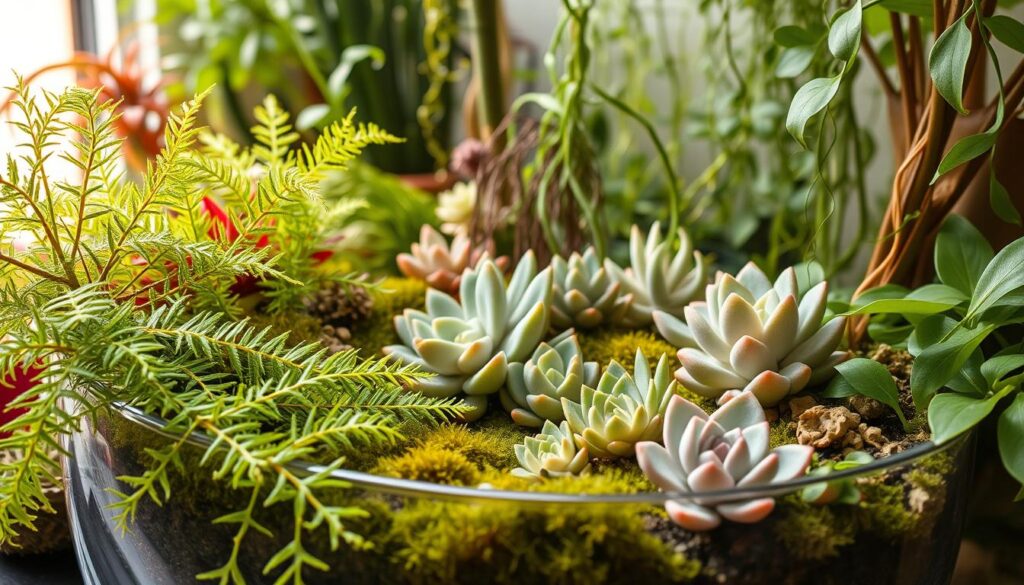
By following these tips and using the right terrarium design essentials, you can create a beautiful and thriving terrarium that adds a touch of greenery to your home decor. Remember to choose the best plants for terrariums and to monitor their condition regularly to ensure they continue to thrive.
| Plant Type | Light Requirements | Humidity Requirements |
|---|---|---|
| Succulents | Low to medium | Low to medium |
| Ferns | Medium to high | High |
| Air Plants | Low to medium | High |
Terrarium Plants for Different Settings
When it comes to incorporating terrarium plants into your space, the possibilities are endless. You can use them to add a touch of greenery to your home office, living room, or even your children’s rooms. Terrarium plants are perfect for indoor gardening, as they are low-maintenance and can thrive in a variety of lighting conditions.
In a home office, terrarium plants can help purify the air and create a calming atmosphere. Some popular options for terrarium plants in a home office include Peperomia, Begonia, and Ferns. For a living room, you can choose plants that are more decorative, such as Orchids or Bromeliads. Children’s rooms can also benefit from terrarium plants, as they can help teach kids about responsibility and the importance of caring for living things.
Here are some tips for choosing the right terrarium plants for your space:
- Consider the lighting conditions: Different plants have different lighting requirements, so make sure to choose plants that will thrive in your space.
- Think about the size: Terrarium plants come in a variety of sizes, so choose plants that will fit comfortably in your space.
- Choose plants that are low-maintenance: If you’re new to indoor gardening, choose plants that are easy to care for and require minimal maintenance.
By following these tips, you can create a beautiful and thriving terrarium that will bring joy and freshness to your space. Whether you’re looking to add some greenery to your home office, living room, or children’s rooms, terrarium plants are a great option for indoor gardening.
| Setting | Recommended Terrarium Plants |
|---|---|
| Home Office | Peperomia, Begonia, Ferns |
| Living Room | Orchids, Bromeliads |
| Children’s Rooms | Low-maintenance plants like Fittonia or Pilea |
Educational Benefits of Terrarium Plants
Creating a succulent terrarium can be a fun and educational experience for children. By engaging with terrarium plants, kids can learn about ecosystems, photosynthesis, and the importance of responsible plant care. This hands-on experience can foster a greater appreciation for nature and the environment, while also promoting essential skills like observation, patience, and responsibility.
Some of the key benefits of using terrarium plants in education include:
- Improved understanding of ecosystems and biology
- Enhanced fine motor skills through planting and arranging materials
- Increased responsibility and self-esteem through plant care
- Opportunities for interdisciplinary learning, including science, math, and art
By incorporating air plants and other low-maintenance species into a terrarium, children can learn about the unique needs and characteristics of different plants. This can help them develop a deeper understanding of the natural world and encourage a lifelong love of learning and exploration.
With the right guidance and support, creating a terrarium can be a fun and rewarding experience for kids. By providing a hands-on introduction to the world of plants and ecosystems, we can inspire the next generation of environmental stewards and promote a greater appreciation for the natural world.
Troubleshooting Common Problems
As you tend to your miniature garden, you may encounter some common problems that can affect the health and beauty of your plants. To help you troubleshoot these issues, we’ve put together a list of common problems and solutions.
Some common problems with terrarium plants include overwatering, underwatering, and high humidity levels. These issues can lead to mold, fungi, and bacterial growth, which can be detrimental to your plants. To prevent these problems, make sure to use the right terrarium supplies, such as a well-draining potting mix or a water meter.
Here are some common problems and solutions to look out for:
- Overwatering: Check the soil moisture by sticking your finger into the soil up to the first knuckle. If the soil feels dry, it’s time to water.
- Underwatering: Check the soil moisture regularly and water your plants when the soil feels dry to the touch.
- High humidity levels: Use a hygrometer to monitor the humidity levels in your terrarium. If the levels are too high, you can try removing the lid for a few hours a day to reduce the humidity.
By following these tips and using the right terrarium supplies, you can create a healthy and thriving miniature garden that will bring you joy and beauty for years to come.
| Problem | Solution |
|---|---|
| Overwatering | Check soil moisture regularly |
| Underwatering | Water plants when soil feels dry |
| High humidity levels | Use hygrometer to monitor humidity levels |
Inspiring Terrarium Plant Projects
Beyond simply enjoying the beauty and benefits of terrarium plants in your own home, you can also get involved in inspiring community-driven initiatives and creative workshops. DIY terrarium kits allow you to unleash your creativity and personalize your indoor garden, while community gardening projects offer a chance to share your passion for these miniature ecosystems with others. Many local garden centers and plant enthusiast groups also host engaging workshops and classes where you can learn new terrarium-building techniques and discover the best plants for terrariums.
Whether you’re interested in crafting your own unique terrarium or collaborating with your neighbors to green up your community, there are plenty of opportunities to explore the world of terrarium ideas and make a positive impact. So why not dive in and discover the joys of sharing your love for these captivating indoor plants?
FAQ
What are terrarium plants?
Terrarium plants are plants that are specifically chosen for their ability to thrive in a closed or partially closed environment. They are often used to create miniature gardens and can include a variety of different plant species such as succulents, air plants, and ferns.
What are the benefits of having terrarium plants?
Terrarium plants offer several benefits, including aesthetic appeal, improved air quality, and low-maintenance requirements. They can add a touch of elegance to any room and help create a sense of calm and tranquility. Additionally, terrarium plants can help remove pollutants and toxins from the air in your home.
What are some popular types of terrarium plants?
Some of the most popular terrarium plants include moss varieties, succulents, and ferns. These plants are relatively low-maintenance and can thrive in a closed or partially closed environment.
What should I consider when choosing terrarium plants?
When choosing terrarium plants, it’s important to consider factors such as light requirements, size, growth habit, and compatibility with other plants. Selecting the right plants can help create a harmonious and balanced terrarium.
How do I create the perfect terrarium environment?
Creating the perfect terrarium environment involves choosing the right container, ensuring proper drainage, and layering the appropriate materials. Attention to these details can help establish a healthy and thriving environment for your terrarium plants.
How do I assemble a terrarium?
Assembling a terrarium involves a step-by-step process, including layout and design considerations. Following a guide and paying attention to the placement and selection of plants and materials can help you create a beautiful and functional terrarium.
How do I care for my terrarium plants?
Caring for your terrarium plants requires attention to proper watering techniques, pruning, and maintenance. Addressing common issues like pests and diseases can also help keep your terrarium plants healthy and thriving.
How can I use terrarium plants for home decor?
Terrarium plants can be used in a variety of creative ways to add greenery and beauty to your home decor, such as using them as centerpieces, wall-mounted terrariums, or unique display pieces.
Where can I use terrarium plants in my home?
Terrarium plants can be incorporated into a variety of settings, including home offices, living rooms, and children’s rooms, to bring a touch of nature and calmness to your spaces.
What are the educational benefits of terrarium plants?
Terrarium plants can be a great educational tool for teaching children about ecosystems and gardening, providing a hands-on learning experience and fostering an appreciation for the natural world.
What are some common problems with terrarium plants?
Terrarium plants can be prone to issues such as overwatering, underwatering, and high humidity levels. Identifying and addressing these problems can help maintain the health and vibrancy of your terrarium plants.
How can I get involved in terrarium plant projects?
There are many inspiring terrarium plant projects, including DIY terrarium kits, community gardening initiatives, and creative workshops and classes. Participating in these types of projects can be a great way to get involved and make a positive impact in your community.
Source Links
- Elevate Your Indoor Garden: 25 Stunning Terrarium Plants to Bring Life to Your Home – https://vocal.media/writers/elevate-your-indoor-garden-25-stunning-terrarium-plants-to-bring-life-to-your-home
- Terrarium Plants for Sale – Greenery for Your Indoor Garden – https://www.tnnursery.net/products/terrarium-garden-kit
- 35 Best Terrarium Plants for a Lovely Indoor Garden of Any Size – https://www.planetnatural.com/terrarium-plants/
- 13 Beginner-friendly Terrarium Plants (Guide for Guaranteed Success) – https://ome.design/blogs/guides/13-beginner-friendly-terrarium-plants?srsltid=AfmBOoqrS3QDSG9CfdICe-4KJVd8qVA8-sGMtKFxGtQhvF8sbvu4q73F
- 25 Easy Terrarium Plants for Open or Closed Glass – https://www.thespruce.com/great-terrarium-plants-847877
- Beginner Terrarium Plants – https://frogdaddy.net/collections/beginner-terrarium-plants?srsltid=AfmBOop0lpwwQeHBkC1_FvI7DhyPQh4izaY6s9adTT_UR7swlfsRh9OI
- The Benefits of Having a Terrarium in Your Home or Office – https://tropicalglass.co.uk/blogs/blog/the-benefits-of-having-a-terrarium-in-your-home-or-office?srsltid=AfmBOooiGqDqcUf6JSpfs4r7Vnqa4Usen3kBjfTEgnkOMrFmnd0A0j6q
- Benefits of Terrariums: 10 Ways They Elevate Your Life & Home – https://terrariumtribe.com/benefits-of-terrariums/
- Terrarium plants – Blooming Lucky – https://bloominglucky.com/terrarium-plants-and-how-to-use-them/
- 25 best terrarium plants for beginners – https://www.gardenersworld.com/house-plants/best-terrarium-plants/
- Terrarium Plants: How To Choose Them and How To Care For Them – https://bloomboxclub.com/blogs/news/terrarium-plants-how-to-choose-them-and-how-to-care-for-them
- Terrarium Plants: How to Choose & Use! (Setup to Success) – https://terrariumtribe.com/terrarium-plants-guide/
- Selecting the Right Plants for your Terrarium – https://www.minibotanics.co.nz/blogs/terrarium-fundamentals/selecting-the-right-plants-for-your-terrarium?srsltid=AfmBOoqxxFSNUivL609DtPBZLa9qIxk-NwRb4E2uGrvQCk0aRTOzBVfk
- How to Make a Terrarium: A Step-By-Step Guide and Video Tutorial – https://phsonline.org/for-gardeners/gardeners-blog/how-to-make-a-terrarium
- Make your own terrarium | Kew – https://www.kew.org/read-and-watch/how-to-make-terrarium
- You Can DIY Your Own Terrarium in 7 Simple Steps—Here’s How – https://www.thespruce.com/how-to-make-terrariums-848007
- Terrarium Kit Instructions: How to Build Your Terrarium – https://ome.design/blogs/guides/how-to-build-a-terrarium?srsltid=AfmBOorZk6wY4Rgzv1xT2iV5gQQZrMLpEHqs2wUYsVESp1GKDLODzQKp
- How to look after a terrarium – https://www.gardenersworld.com/house-plants/how-to-look-after-a-terrarium/
- Common Terrarium Mistakes and How to Avoid Them – https://www.thespruce.com/common-terrarium-mistakes-847861
- How to Create and Care for a Terrarium – https://yardandgarden.extension.iastate.edu/how-to/how-create-and-care-terrarium
- Simpler Ways to Use Terrariums | Terrarium Decor | Accent Decor Blog – https://www.accentdecor.com/blog/2024/03/simpler-ways-to-use-terrariums/
- How to Design a Closed-System Terrarium – http://extension.msstate.edu/publications/how-design-closed-system-terrarium
- Trending Terrarium Plants for Every Room in the Home – https://primexgardencenter.com/indoor-terrarium-plants/
- A Guide to Popular Terrarium Plants – https://www.dendroboard.com/threads/a-guide-to-popular-terrarium-plants.35324/
- Top 10 Best Selling Terrarium Plants | Little Prince To Go – https://littleprinceplants.com/blog/top-10-best-selling-terrarium-plants/
- Live Plant Kit For 18X18X24 Terrarium Bioactive Terrariums & Live Vivariums | NEHERP – https://www.neherpetoculture.com/plantkit18x18x24
- Terrariums: a creative way to stimulate children’s imaginations – https://be.green/en/blog/terrariums-creative-way-stimulate-children-imaginations?srsltid=AfmBOooM8r0Ex1lJokO9QeZlRQM4eWrMc2m7GMEtKJyV8-0MYQxN7ZMF
- 6 Benefits of Creating Terrariums with Kids: Why it’s a Great Idea for Creativity, Responsibility, and Education – https://cutefarms.com/blogs/blog/6-benefits-of-creating-terrariums-with-kids-why-its-a-great-idea-for-creativity-responsibility-and-education?srsltid=AfmBOorgojNNZHKB-JrRNmL7lQ2rnwDGLZhgxR9spTYo85c97hWbi3QU
- Encouraging Growth: Why Terrariums Are Great For The Primary Classroom! – https://greenibisblog.wordpress.com/2016/05/14/encouraging-growth-why-terrariums-are-great-for-the-primary-classroom/
- Common Terrarium Problems: A Guide To Fix & Prevent Issues – https://bantam.earth/terrarium-problems/
- Terrarium Troubleshooting | Solve Gardening Problems – https://londonterrariums.com/blogs/terrarium-101/terrarium-troubleshooting?srsltid=AfmBOooHuGOd0m12mNj1FvDoINdLcwCJHMQdM3ecCDRz9dCZdPJT9DFr
- Terrarium Troubleshooting: How to Fix Common Problems – https://lilasgarden.com.au/blogs/news/terrarium-troubleshooting-how-to-fix-common-problems?srsltid=AfmBOooMBek87pzRRgLlm_ENGRfbrybVFNiWrjHCT4dof-qjRU45_lEr
- The 11 best plants to grow in your terrarium – https://www.ksby.com/best-plants-to-grow-in-your-terrarium
- How to Make a Terrarium | Nature Based Projects with Kids – wildtalesof.com – https://wildtalesof.com/nature-based-projects-make-terrarium/

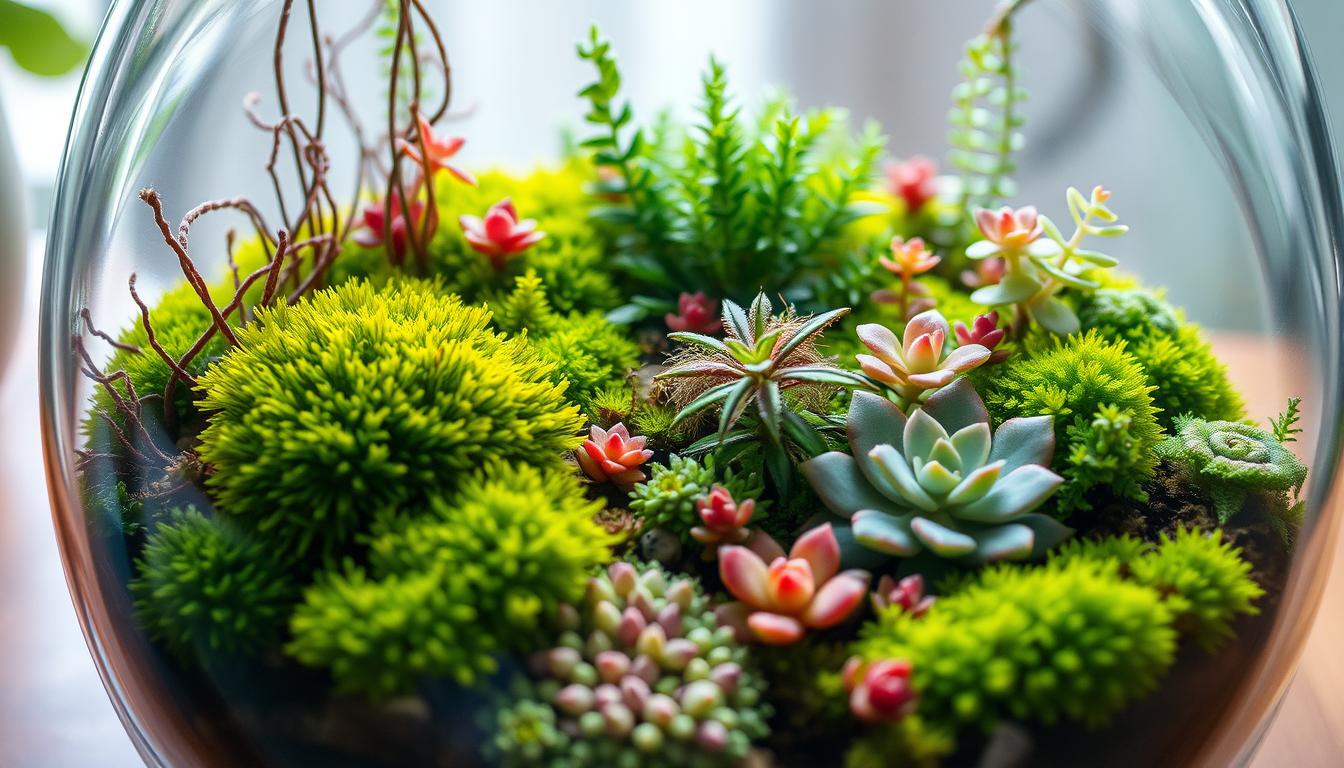
1 thought on “Terrarium Plants: Elevate Your Indoor Garden”